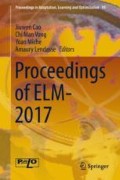Abstract
Extreme learning machine is a new type of algorithm for single hidden layer feedforward neural network. Compared with the traditional algorithms, ELM avoids long time iteration and has the advantages of high speed, small errors. Among them, the activation function plays an important role in the system. Whereas the general ELM usually uses Sigmod function as the activation function, a new kind ELM using memristor’s memristance-charge function as activation function is proposed in this article. Experiments show that, compared with the ELM and the traditional neural network algorithms, the extreme learning machine based on memristance-charge activation function can shorten the time and improve the accuracy. In a word, it has better classification and regression performances.
The work was supported by National Natural Science Foundation of China (Grant Nos. 61571372, 61672436), Fundamental Research Funds for the Central Universities (Grant Nos. XDJK2016A001, XDJK2017A005).
Access this chapter
Tax calculation will be finalised at checkout
Purchases are for personal use only
References
Zheng, Y.X.: SVM parameter optimization based on hybrid bionic algorithm. J. Guangxi Norm. Univ. 29(2), 114–118 (2011)
Huang, G.B., Zhu, Q.Y., Siew, C.K.: Extreme learning machine: a new learning scheme of feedforward neural networks. In: IEEE International Joint Conference on Neural Networks, Proceedings IEEE, vol. 2, pp. 985–990 (2005)
Chua, L.O.: Memristor-the missing circuit element. IEEE Trans. Circ. Theor. 18(5), 507–519 (1971)
Strukov, D.B., Snider, G.S., Stewart, D.R., Williams, R.S.: The missing memristor found. Nature 453(7191), 8083 (2008)
Pershin, Y.V., Di, V.M.: Spin memristive systems: spin memory effects in semiconductor spintronics. Phys. Rev. B 78(11), 113309 (2008)
Zong, W., Huang, G.B., Chen, Y.: Weighted extreme learning machine for imbalance learning. Neurocomputing 101(3), 229–242 (2013)
Geng, Z.Q., Qin, L., Han, Y.M., et al.: Energy saving and prediction modeling of petrochemical industries: a novel ELM based on FAHP. Energy 122, 350–362 (2017)
Bi, W.C.: A particle swarm optimization based on extreme learning machine. J. Zhengzhou Univ. 45(1), 100–104 (2013)
Zong, W., Huang, G.B.: Face recognition based on extreme learning machine. Neurocomputing 74(16), 2541–2551 (2011)
Huang, G.B., Zhou, H., Ding, X., et al.: Extreme learning machine for regression and multiclass classification. IEEE Trans. Syst. Man Cybern. 42(2), 513–529 (2012)
Liang, N.Y., Huang, G.B., Saratchandran, P., et al.: A fast and accurate online sequential learning algorithm for feedforward networks. IEEE Trans. Neural Netw. 17(6), 1411–1423 (2006)
Samat, A., Du, P., Liu, S., et al.: Ensemble extreme learning machines for hyperspectral image classification. IEEE J. Sel. Top. Appl. Earth Obs. Remote. Sens. 7(4), 1060–1069 (2014)
Bi, H.Y.: The extreme learning machine application in handwritten numeral recognition. Zhengzhou University (2014)
Wang, L., Drakakis, E., Duan, S., et al.: Memristor model and its application for chaos generation. Int. J. Bifurc. Chaos 22(8), 241–252 (2012)
Strukov, D.B., Snider, G.S., Stewart, D.R., et al.: The missing memristor found. Nature 453(7191), 80–83 (2008)
Liu, P.: Research on image classification algorithm based on ELM. China Jiliang University (2012)
Yaming, Xu, Lidan, Wang, Shukai, Duan: Magnetron TiO2 memristor chaotic system and FPGA hardware implementation. Phys. Sci. J. 65(12), 62–74 (2016)
Author information
Authors and Affiliations
Corresponding author
Editor information
Editors and Affiliations
Rights and permissions
Copyright information
© 2019 Springer Nature Switzerland AG
About this paper
Cite this paper
Li, H., Wang, L., Duan, S. (2019). A Kind of Extreme Learning Machine Based on Memristor Activation Function. In: Cao, J., Vong, C., Miche, Y., Lendasse, A. (eds) Proceedings of ELM-2017. ELM 2017. Proceedings in Adaptation, Learning and Optimization, vol 10. Springer, Cham. https://doi.org/10.1007/978-3-030-01520-6_19
Download citation
DOI: https://doi.org/10.1007/978-3-030-01520-6_19
Published:
Publisher Name: Springer, Cham
Print ISBN: 978-3-030-01519-0
Online ISBN: 978-3-030-01520-6
eBook Packages: Intelligent Technologies and RoboticsIntelligent Technologies and Robotics (R0)

